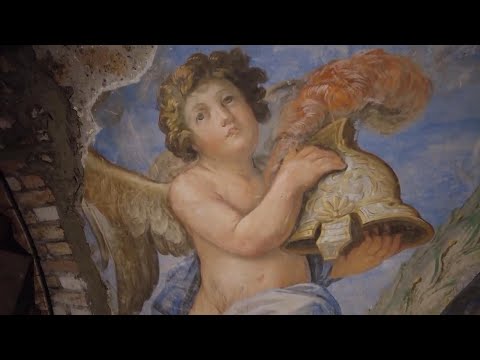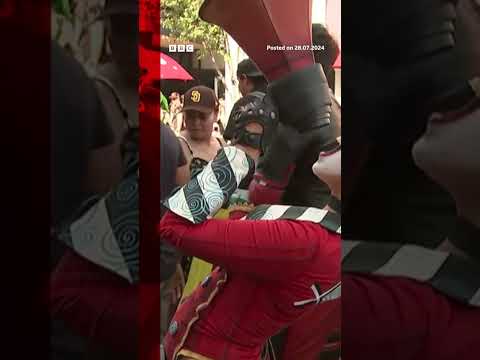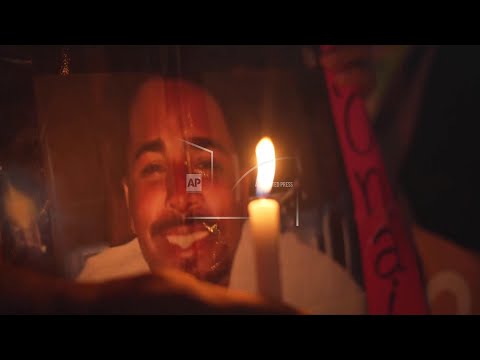(21 Nov 2024)
ITALY HIDDEN FRESCOES
SOURCE: ASSOCIATED PRESS
RESTRICTIONS:
LENGTH: 7:24
ASSOCIATED PRESS
Rome, Italy – 19 November 2024
1. Electrician Davide Renzoni opening a trapdoor and climbing a ladder to the floor with the frescoes
2. Zoom in of Davide Renzoni looking at cherub fresco
3. Tilt up of the frescoed cherub
4. Close of landscape fresco
5. Various of the frescoes
6. SOUNDBITE (Italian) Davide Renzoni, electrician who discovered the fresco:
"That morning, during a classic routine maintenance check, I went upstairs and although the lighting was poor and the room was not in this condition, there were residues of old workings, I went up and the first thing I saw was the landscape behind me and this ‘putto’ (cherub). Then I saw that there was another trapdoor, I went to get a lamp to have more visibility and when I turned it on, out came this wonder, these frescoes. My first feeling, since I am not an expert in the field and I had never experienced something like this before, was astonishment, immense astonishment."
7. Tilt up from the top of the false ceiling of the atrium to the fresco on the ceiling
8. Various of the frescoes
9. Electrician Davide Renzoni looking at the fresco from an opening in the wall
10. Close of the fresco above the false ceiling
11. SOUNDBITE (Italian) Virginia Lapenta, curator of Villa Farnesina:
"The surprise, as you can imagine, was accompanied by great emotion, also due to the fact that the Accademia dei Lincei now carries out numerous studies and research projects at Villa Farnesina through a cultural heritage research centre, called CERIF. So the reinterpretation of this 17th-century surface deepens all the diachronic readings of the palace that we have been carrying out for years and supports what we already know, i.e. Raphael’s period."
12. Various of one of the frescoed cherubs
13. Visitor taking a photo of the three pictures of the frescoes on display in the exhibition
14. Various of screens showing the frescoes in real time
15. SOUNDBITE (Italian) Virginia Lapenta, curator of Villa Farnesina:
"This sector, this area, was divided in the 19th century into the current two rooms, the one we call the ex-ticket office because it was once the museum’s ticket office, and the atrium with 19th century decorations commissioned by the Duke of Ripalda who was resident in the villa in the 19th century. These structural transformations led to the creation of the two current vaults, so the decorations are above these 19th century vaults in what is the gap between the 19th-century architectural phase and the single vault of the Chigi atrium from the 16th and 17th centuries."
16. Various of the frescoed ceiling of the atrium that was built, covering the recently-discovered frescoed ceiling
17. SOUNDBITE (Italian) Virginia Lapenta, curator of Villa Farnesina:
"Initial studies being carried out by the Accademia dei Lincei in a dedicated research study show that the decorations were carried out at the time when, we know historically, the great painter Carlo Maratta arrived at the Villa Farnesina, sent by Ranuccio II Farnese. Carlo Maratta had his pupils working on this site, which was basically a restoration site for Raphael’s famous loggias. But today, through these new frescoes, we understand that he (Maratta) also intervened in this area, architecturally less representative but very functional, which was the entrance from Agostino Chigi’s secret garden, the living room where the banker ate his daily meals."
19. Mid of two visitors looking up at Raphael’s frescoes
20. Close of a detail of Raphael’s fresco
STORYLINE:
Find out more about AP Archive: http://www.aparchive.com/HowWeWork
Twitter: https://twitter.com/AP_Archive
Facebook: https://www.facebook.com/APArchives
Instagram: https://www.instagram.com/APNews/
You can license this story through AP Archive: http://www.aparchive.com/metadata/youtube/e14ae85db9fc40779e491e64f446f112
Author: AP Archive
Go to Source
News post in November 26, 2024, 3:04 pm.
Visit Our Sponsor’s:
News Post In – News





